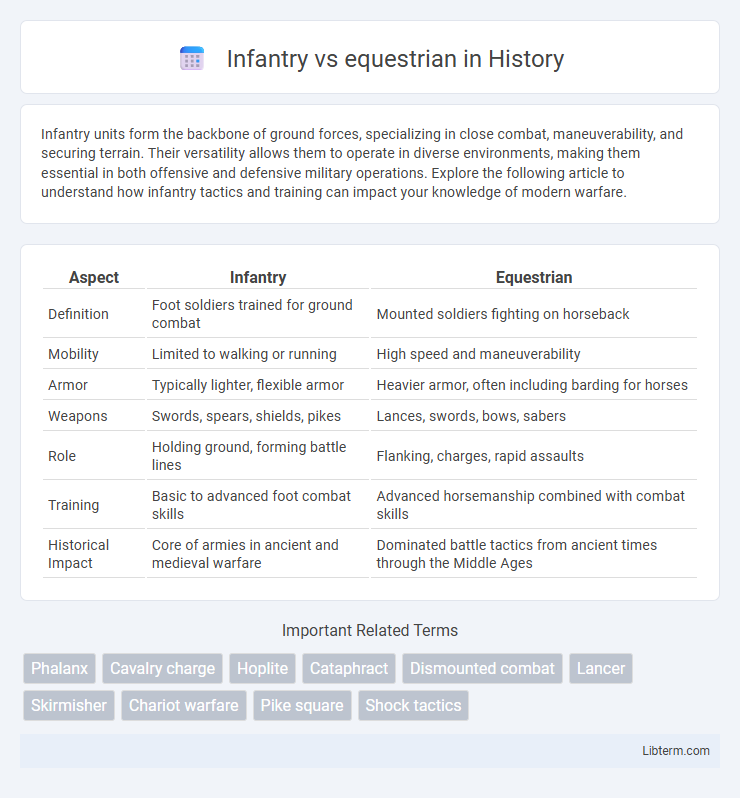Infantry units form the backbone of ground forces, specializing in close combat, maneuverability, and securing terrain. Their versatility allows them to operate in diverse environments, making them essential in both offensive and defensive military operations. Explore the following article to understand how infantry tactics and training can impact your knowledge of modern warfare.
Table of Comparison
| Aspect | Infantry | Equestrian |
|---|---|---|
| Definition | Foot soldiers trained for ground combat | Mounted soldiers fighting on horseback |
| Mobility | Limited to walking or running | High speed and maneuverability |
| Armor | Typically lighter, flexible armor | Heavier armor, often including barding for horses |
| Weapons | Swords, spears, shields, pikes | Lances, swords, bows, sabers |
| Role | Holding ground, forming battle lines | Flanking, charges, rapid assaults |
| Training | Basic to advanced foot combat skills | Advanced horsemanship combined with combat skills |
| Historical Impact | Core of armies in ancient and medieval warfare | Dominated battle tactics from ancient times through the Middle Ages |
Introduction: Defining Infantry and Equestrian Forces
Infantry refers to soldiers trained, equipped, and deployed primarily on foot to engage in ground combat, emphasizing mobility, close-quarters fighting, and strategic positioning. Equestrian forces, or cavalry, consist of troops mounted on horses, providing enhanced speed, shock tactics, and greater tactical flexibility on various terrains. Both forces have distinct roles and combat advantages shaped by their mode of mobility and battlefield responsibilities.
Historical Evolution of Infantry and Cavalry
The historical evolution of infantry and cavalry reveals distinct tactical roles shaped by technological advancements and battlefield demands. Infantry, initially characterized by heavily armored foot soldiers, gradually incorporated ranged weaponry like bows and arquebuses to enhance versatility, while cavalry evolved from mere horseback archers to heavily armored knights dominating medieval warfare. The rise of gunpowder weapons in the early modern period reduced cavalry's battlefield supremacy, leading to more specialized roles such as reconnaissance and shock troops, whereas infantry formations adapted with muskets, bayonets, and later mechanized support to maintain frontline dominance.
Weaponry and Tactical Advantages
Infantry units typically wield versatile weapons like rifles, machine guns, and grenades, providing effective close to medium-range combat capabilities, while cavalry forces often utilize sabers, lances, and pistols optimized for swift, close-quarters engagements. Infantry formations excel in holding ground, fortification assaults, and sustained firepower deployment, benefiting from modern cover and terrain adaptation. Cavalry offers superior mobility and shock impact, enabling rapid flanking maneuvers, reconnaissance, and disruption of enemy lines before infantry can effectively respond.
Terrain and Environmental Influence
Infantry units demonstrate superior adaptability across diverse terrains, excelling in dense forests, rugged mountains, and urban environments where mobility and cover are critical. Equestrian forces maintain significant advantages on open plains and flat terrain, leveraging speed and maneuverability to outflank opponents. Environmental factors such as muddy ground, steep inclines, or thick vegetation drastically reduce cavalry effectiveness while minimally impacting infantry movement and tactical positioning.
Mobility and Deployment Strategies
Infantry units rely on foot mobility, enabling them to navigate diverse terrains but limiting rapid long-distance movement compared to equestrian forces. Equestrian units offer superior speed and flexibility, allowing swift deployment and flanking maneuvers across open landscapes. Deployment strategies for infantry emphasize tactical positioning and defensive formations, while cavalry prioritizes surprise attacks and rapid engagement or retreat.
Armor and Protection Mechanisms
Infantry armor historically relied on chainmail, plate armor, and padded gambesons to balance mobility with protection against melee weapons and projectiles. Equestrian armor, or cavalry armor, was often heavier and more robust, featuring reinforced breastplates, full helmets, and limb guards designed to protect both rider and horse during mounted combat. Innovative protection mechanisms like barding for horses and articulation in plate armor enhanced durability while allowing cavalry to maintain speed and offensive capability.
Key Battles: Infantry vs Equestrian Outcomes
Infantry often gained the upper hand in key historical battles due to disciplined formations and strategic positioning, such as in the Battle of Marathon where heavily armed infantry repelled cavalry charges. Equestrian units excelled in mobility and shock tactics, evidenced by their dominance in the Battle of Gaugamela, where swift horsemen disrupted Persian infantry lines. Outcomes depended heavily on terrain and tactical decisions, with infantry prevailing in constricted spaces and cavalry succeeding in open fields.
Technological Innovations and Their Impact
Technological innovations such as the development of steel weapons, advanced armor, and gunpowder drastically transformed infantry and equestrian warfare. Infantry units benefited from improved firearms and mass production techniques, enabling greater firepower and tactical formations, while cavalry effectiveness declined due to vulnerability against ranged weaponry and artillery. Despite initial dominance, equestrian forces adapted by integrating lighter armor and firearms, yet infantry remained the core of military strategy due to technological advancements increasing their operational versatility and battlefield sustainability.
Modern Transformations: Legacy and Adaptations
Modern transformations in infantry and equestrian units reveal a significant shift from traditional combat roles to technologically advanced adaptations. Infantry forces increasingly integrate unmanned systems, wearable tech, and urban warfare tactics, enhancing mobility and situational awareness. Equestrian roles, largely ceremonial today, retain strategic value in specialized terrains and peacekeeping missions, embodying a legacy adapted through selective mechanization and preservation of historical skills.
Conclusion: The Enduring Debate
The enduring debate between infantry and equestrian forces centers on their complementary strengths in warfare, with infantry providing versatility and endurance while cavalry offers speed and shock impact. Historically, the effectiveness of each depended on terrain, tactics, and technological advancements, shaping military strategies from ancient to modern times. Understanding their distinct roles highlights why combined arms approach remains essential in contemporary combat operations.
Infantry Infographic

 libterm.com
libterm.com